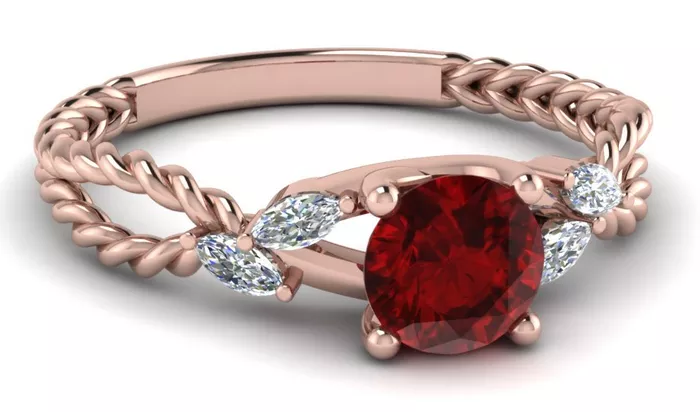Natural rubies are highly valued in the jewelry industry, fetching exorbitant prices due to a combination of unique factors. This article aims to provide a detailed, logical, and popular science-style explanation of the reasons behind the high prices of natural rubies.
Rarity and Formation
Natural rubies are among the rarest gemstones in the world. Their scarcity is a primary reason for their high price. Rubies are formed under specific geological conditions, requiring high temperatures and pressures over millions of years. The primary sources of rubies include countries like Myanmar (Burma), Sri Lanka, Thailand, and Brazil, where the geological structures and mineral resources are conducive to their formation.
The process of ruby formation begins with the crystallization of aluminum oxide (corundum) in the presence of chromium, which gives the ruby its iconic red color. The铬 element is crucial as it determines the color intensity and purity of the ruby. The combination of these factors is not only rare but also occurs in limited geological zones, making rubies exceptionally hard to find.
Color and Clarity
The value of a ruby is heavily influenced by its color and clarity. The most sought-after rubies are those with a vivid, pure red color, often described as “pigeon’s blood” red. This color is the most rare and commands the highest prices. Rubies with secondary colors such as pink or purple are also valuable but typically fetch lower prices compared to pure red ones.
Clarity refers to the absence of inclusions or flaws within the gemstone. A ruby with high clarity is more valuable because it allows for better light transmission and reflection, enhancing its overall beauty and brilliance. Natural rubies often contain inclusions, such as rutile silk or fluid inclusions, which can affect their clarity and, consequently, their value. The fewer and less visible these inclusions, the higher the price of the ruby.
Size and Cut
Size is another critical factor determining the price of a ruby. Larger rubies are rare and, therefore, more expensive. The larger the gemstone, the more difficult it is to find one with good color, clarity, and cut. Carat weight is a significant factor in pricing rubies, and the price per carat typically increases exponentially with size.
The cut of a ruby is crucial for maximizing its beauty and value. A well-cut ruby will have a balanced proportion between its depth, width, and table size, ensuring optimal light performance. The cutter must strike a balance between retaining carat weight and achieving an attractive appearance. Poorly cut rubies may appear dull or lack brilliance, reducing their value despite their potential color and clarity.
Demand and Supply
The demand for natural rubies far exceeds their supply, driving up prices. Rubies have held cultural and symbolic significance across various civilizations, making them highly sought-after for jewelry and investment purposes. In many cultures, rubies symbolize love, passion, and power, making them ideal for engagement rings, anniversary gifts, and other significant occasions.
The increasing demand for rubies, coupled with their limited availability, creates a supply-demand imbalance. This imbalance results in high prices and strong market demand, even for smaller and less perfect rubies. As economies grow and disposable income increases, more people can afford to buy luxury items like natural rubies, further pushing up prices.
Cultural Significance
Rubies have a rich history and cultural significance that adds to their value. For centuries, rubies have been associated with royalty, power, and love. In ancient times, they were believed to possess magical powers and were used in talismans and religious artifacts. This historical and cultural association has made rubies highly valuable and sought-after, particularly in cultures where they hold special significance.
In many Asian countries, rubies are considered auspicious and are often given as gifts during significant life events like weddings and births. Their cultural significance and traditional value have helped maintain a strong demand for rubies, even during economic downturns.
Investment Potential
Rubies are considered a valuable investment due to their scarcity, beauty, and cultural significance. Over the long term, the value of natural rubies has generally appreciated, making them a sound investment option. Unlike some other investments, rubies are tangible assets that can be enjoyed and worn while appreciating in value.
Investors often look for high-quality rubies with excellent color, clarity, and cut, as these are likely to retain their value and appreciate over time. The limited supply of high-quality rubies ensures that demand will continue to outstrip supply, supporting price growth.
Difficulty in Mining and Production
Mining natural rubies is a challenging and labor-intensive process. Ruby deposits are often located in remote and inaccessible areas, making extraction difficult and costly. Additionally, the extraction process can be environmentally destructive, leading to increased regulatory scrutiny and costs.
Once extracted, rubies require skilled cutting and polishing to bring out their beauty and maximize their value. The cutting and polishing process is labor-intensive and requires highly skilled craftsmen. The combination of mining difficulties, environmental concerns, and the need for skilled labor contributes to the high cost of producing natural rubies.
Conclusion
Natural rubies are exceptionally valuable due to their rarity, unique color, clarity, size, cultural significance, investment potential, mining and production difficulties, and the need for quality assurance and certification. These factors combined make natural rubies a highly sought-after gemstone with a strong market demand and high prices. Understanding these reasons helps explain why natural rubies continue to be a cornerstone of the jewelry industry and a cherished possession for many collectors and enthusiasts.
Related topic:
- Rhodolite vs. Ruby: What Is the Difference?
- Can Ruby and Yellow Sapphire Be Worn Together?
- Can Ruby and Yellow Sapphire Be Worn Together


